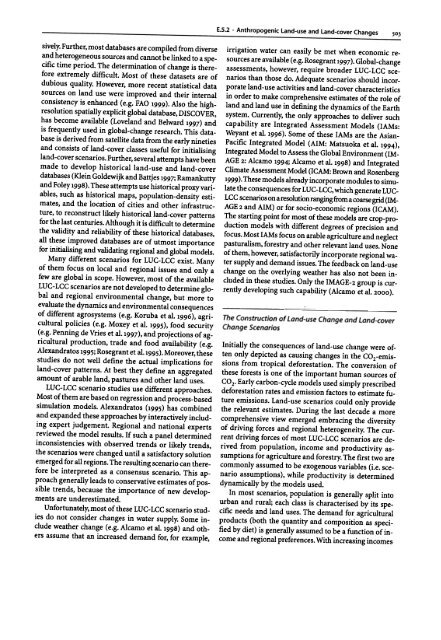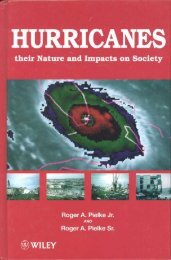How to evaluate vulnerability in changing environmental conditions
How to evaluate vulnerability in changing environmental conditions
How to evaluate vulnerability in changing environmental conditions
Create successful ePaper yourself
Turn your PDF publications into a flip-book with our unique Google optimized e-Paper software.
The<br />
sively. Further, most databases are compiled from diverse irrigation water can easily be met when economic reand<br />
heterogeneous sources and cannot be l<strong>in</strong>ked <strong>to</strong> a spe- sources are available (e.g. Rosegrant 1997). Global-change<br />
cific time period. The determ<strong>in</strong>ation of change is there- assessments, however, require broader LUC-LCC scefore<br />
extremely difficult. Most of these datasets are of narios than those do. Adequate scenarios should <strong>in</strong>cordubious<br />
quality. <strong>How</strong>ever) more recent statistical data porate land-use activities and land-cover characteristics<br />
sources on land use were improved and their <strong>in</strong>ternal <strong>in</strong> order <strong>to</strong> make comprehensive estimates of the role of<br />
consistency is enhanced (e.g. FAO 1999). Also the high- land and land use <strong>in</strong> def<strong>in</strong><strong>in</strong>g the dynamics of the Earth<br />
resolution spatially explicit global database, DISCOVER, system. Currently) the only approaches <strong>to</strong> deliver such<br />
has become available (Loveland and Belward 1997> and capability are Integrated Assessment Models (lAMs:<br />
is frequently used <strong>in</strong> global-change research. This data- Weyant et al. 1996). Some of these lAMs are the Asianbase<br />
is derived from satellite data from the early n<strong>in</strong>eties Pacific Integrated Model (AIM: Matsuoka et al. 1994),<br />
and consists of land-cover classes useful for <strong>in</strong>itialis<strong>in</strong>g Integrated Model <strong>to</strong> Assess the Global Environment (IMland-cover<br />
scenarios. Further, several attempts have been AGE 2: Alcamo 1994; Alcamo et al. 1998) and Integrated<br />
made <strong>to</strong> develop his<strong>to</strong>rical land-use and land-cover Climate Assessment Model (ICAM: Brown and Rosenberg<br />
databases (Kle<strong>in</strong> Goldewijk and Battjes 1997; Ramankutty 1999). These models already <strong>in</strong>corporate modules <strong>to</strong> simuand<br />
Foley 1998). These attempts use his<strong>to</strong>rical proxyvari- late the consequences for LUC-LCC) which generate LUCables,<br />
such as his<strong>to</strong>rical maps, population-density esti- LCC scenarios on a resolution rang<strong>in</strong>g from a coarse grid (IMmates)<br />
and the location of cities and other <strong>in</strong>frastruc- AGE 2 and AIM) or for socio-economic regions (ICAM).<br />
ture, <strong>to</strong> reconstruct likely his<strong>to</strong>rical land-cover patterns The start<strong>in</strong>g po<strong>in</strong>t for most of these models are crop-profor<br />
the last centuries. Although it is difficult <strong>to</strong> determ<strong>in</strong>e duction models with different degrees of precision and<br />
the validity and reliability of these his<strong>to</strong>rical databases, focus. Most lAMs focus on arable agriculture and neglect<br />
all these improved databases are of utmost importance pasturalism, forestry and other relevant land uses. None<br />
for <strong>in</strong>itialis<strong>in</strong>g and validat<strong>in</strong>g regional and global models. of them, however, satisfac<strong>to</strong>rily <strong>in</strong>corporate regional wa-<br />
Many different scenarios for LUC- LCC exist. Many ter supply and demand issues. The feedback on land-use<br />
of them focus on local and regional issues and only a change on the overly<strong>in</strong>g weather has also not been <strong>in</strong>few<br />
are global <strong>in</strong> scope. <strong>How</strong>ever) most of the available cluded <strong>in</strong> these studies. Only the IMAGE-2 group is cur-<br />
LUC-LCC scenarios are not developed <strong>to</strong> determ<strong>in</strong>e global<br />
and regional <strong>environmental</strong> change, but more <strong>to</strong><br />
rently develop<strong>in</strong>g such capability (Alcamo et al. 2000).<br />
<strong>evaluate</strong> the dynamics and <strong>environmental</strong> consequences '<br />
of different agrosystems (e.g. Koruba et al. 1996), agricultural<br />
policies (e.g. Moxey et al. 1995») food security<br />
(e.g. Penn<strong>in</strong>g de Vries et al.1997), and projections of ag-<br />
Construction of Land-use Change and Land-coverChange<br />
Scenarios<br />
ricultural production, trade and food availability (e.g. Initially the consequences of land-use change were of-<br />
Alexandra<strong>to</strong>s 1995; Rosegrant et al.1995).Moreover)these ten only depicted as caus<strong>in</strong>g changes <strong>in</strong> the CO2-emisstudies<br />
do not well def<strong>in</strong>e the actual implications for sions from tropical deforestation. The conversion of<br />
land-cover patterns. At best they def<strong>in</strong>e an aggregated these forests is one of the important human sources of<br />
amount of arable land, pastures and other land uses. CO2. Early carbon-cycle models used simply prescribed<br />
LUC-LCC scenario studies use different approaches. deforestation rates and emission fac<strong>to</strong>rs <strong>to</strong> estimate fu-<br />
Most of them are based on regression and process- based ture emissions. Land-use scenarios could only provide<br />
simulation models. Alexandra<strong>to</strong>s (1995) has comb<strong>in</strong>ed the relevant estimates. Dur<strong>in</strong>g the last decade a more<br />
and expanded these approaches by <strong>in</strong>teractively <strong>in</strong>clud- comprehensive view emerged embrac<strong>in</strong>g the diversity<br />
<strong>in</strong>g expert judgement. Regional and national experts of driv<strong>in</strong>g forces and regional heterogeneity. The curreviewed<br />
the model results. If such a panel determ<strong>in</strong>ed rent driv<strong>in</strong>g forces of most LUC-LCC scenarios are de<strong>in</strong>consistencies<br />
with observed trends or likely trends) rived from population, <strong>in</strong>come and productivity asthe<br />
scenarios were changed until a satisfac<strong>to</strong>ry solution sumptions for agriculture and forestry. The first two are<br />
emerged for all regions. The result<strong>in</strong>g scenario can there- commonly assumed <strong>to</strong> be exogenous variables (i.e. scefore<br />
be <strong>in</strong>terpreted as a consensus scenario. This ap- nario assumptions), while productivity is determ<strong>in</strong>ed<br />
proach generally leads <strong>to</strong> conservative estimates of pos- dynamically by the models used.<br />
sible trends, because the importance of new develop- In most scenarios) population is generally split <strong>in</strong><strong>to</strong><br />
ments are underestimated. urban and rural; each class is characterised by its spe-<br />
Unfortunately) most of these LUC-LCC scenario stud- cific needs and land uses. The demand for agricultural<br />
ies do not consider changes <strong>in</strong> water supply. Some <strong>in</strong>- products (both the quantity and composition as speciclude<br />
weather change (e.g. Alcamo et al. 1998) and oth- fied by diet) is generally assumed <strong>to</strong> be a function of <strong>in</strong>ers<br />
assume that an <strong>in</strong>creased demand for, for example) come and regional preferences. With <strong>in</strong>creas<strong>in</strong>g <strong>in</strong>comes














